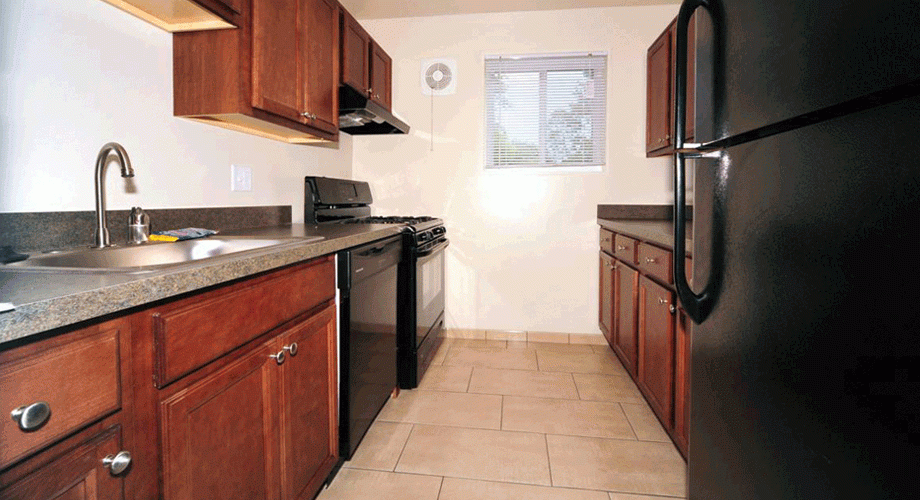The renovation playbook reads something like this: Take a B or B+ community, install granite countertops, add wood or wood-style vinyl flooring and touch up an amenity or two. Voilà, you have a Class A apartment community.
ROSS Companies didn’t follow that playbook in its recent renovation of Overlook Apartments in Hyattsville, Md. In a move that flies in the face of the typical value-add model, ROSS Companies transformed what was a market-rate product into a modern, fully renovated, affordable apartment community that both increased revenue while also improving the lifestyles of affordable residents.
“It was a backward renovation,” says Jason Klippel, Vice President of Development and Construction for ROSS. “But it was a good business move because it increased revenue and our ownership position in the asset, and also added significant value for the residents and the Chillum Heights neighborhood without increasing rents.”
Although restricted in the types of finishes it could install in the community per HUD loan guidelines, ROSS invested $9.4 million to create an affordable community that rivaled many of its market-rate peers.
Among the renovations were new wood kitchen and bathroom cabinets and countertops, ceramic tile floors and bathtub surrounds, new carpet throughout, energy-efficient light fixtures and new electrical wiring in every apartment home. The outside of the community also received several upgrades, including new roofs, new windows and restored exterior masonry.
Keeping Resident Base
“In terms of quality, Overlook Apartments are on par with every market-rate community in the area of similar vintage,” Klippel says. “The one advantage that Overlook has is that everything is 100 percent renovated, whereas a market-rate community may be partially renovated.
The transformation from market rate to affordable did create its own set of operational challenges. Current residents couldn’t continue living at the renovated community unless they qualified for affordable housing, meaning they could earn no more than 60 percent of the region’s area median income. In addition, the HUD financing required ROSS to lease-up the community quickly or risk losing some tax credits.
To ensure it was able to retain as many residents as possible, ROSS implemented several tactics. First, the company decided to renovate the community building by building, allowing it to move current residents into available apartment homes or offer them the opportunity to move back into the community soon after the renovations were complete.
Residents had to qualify for affordable housing to transfer to another unit or to move back in, so ROSS also implemented a prequalification process for all residents who wanted to stay. Residents who didn’t qualify were provided a moving stipend to cover their moving costs to another community.
Higher Occupancy
“One unique thing about this property is that a lot of the residents qualified under the program,” says Don Stocks, Vice President of Operations for ROSS. “We coveted the people who were living at the community, because we knew that we could keep them if we explained the renovation to them, helped them get qualified for the program and assisted them in moving out and back into the apartment.”
Although ROSS didn’t push rents, it increased revenue through stronger occupancy, taking the community from 90 percent occupied prior to the renovation to 96 percent occupied after renovation as of Q1 2015 and created expense savings.
Additionally, ROSS was able to give back to a neighborhood it has served for nearly 30 years through affordable housing and a partnership established in conjunction with the renovation with Learning Ally to help students overcome challenges associated with learning disabilities, such as dyslexia.
“We have people who had lived at the community for many years, been long-term residents and couldn’t believe they could move back in and effectively not pay any more in rent for that kind of product,” Stocks says. “As an owner-operator, there’s a sense of pride to be able to provide that kind of housing and environment for people who have hoped their whole lives to live in something like this.”
And the results have been reflected in the community’s reviews on ApartmentRatings.com, where one resident writes, “I moved here in 2012 before the renovations, and that experience was great. After the renovations and getting to know the staff and community more, my experience was even better! I highly recommend these apartments.”
So much for the renovation playbook. ROSS’s renovation of Overlook Apartments flipped the playbook on its head to generate value for its portfolio, value for its residents and value for the Chillum Heights neighborhood.
Peter Jakel is an Account Director for LinnellTaylor Marketing
